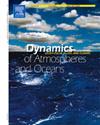Aircraft observations of tropical cyclones core structure over the South China Sea and their impacts on track and intensity forecasts
IF 1.9
4区 地球科学
Q2 GEOCHEMISTRY & GEOPHYSICS
引用次数: 0
Abstract
In this study, characteristics of wind and temperature in the inner-core region of tropical cyclones (TCs) are analyzed using dropsonde data from three aircraft observation missions over the South China Sea (SCS) conducted by the Hong Kong Observatory between 2022 and 2023. The impact of assimilating inner-core dropsonde data on TC track and intensity forecasts is also evaluated. Results indicate that both TCs Nesat and Suola exhibit shared features: Tangential wind speeds weaken significantly above 850–500 hPa; A distinct warm core structure persists between 700 and 300 hPa; The boundary layer height varies across cases. Two parallel experiments,ASSI_drop (with inner-core dropsonde assimilation) and No_da (without assimilation), were implemented using the GRAPES (Global/Regional Assimilation and Prediction System) model with 3DVar. Data assimilation significantly reduced 72-hour mean track errors (49 % of reduction), while intensity forecasts showed neutral to weak positive improvements. The track improvement closely aligns with Feng et al. (2023)'s reduction via inner-core assimilation in northern SCS cases, while substantially exceeding the 10–13 % range documented in analogous SCS studies (Chan et al., 2018; Zhang et al., 2020). North Pacific DOTSTAR(Dropwindsonde Observations for Typhoon Surveillance near the Taiwan Region)cases demonstrated a 22 % mean improvement (Wu et al., 2007), contrasting with the SCS's 10–49 % variability range. This regional inconsistency underscores the necessity for expanded airborne dropsonde campaigns across the SCS to establish result representativeness and regional applicability.
南海热带气旋核心结构的飞机观测及其对路径和强度预报的影响
本文利用香港天文台于2022年至2023年在南海上空进行的三次飞机观测任务,分析了热带气旋内心区的风和温度特征。本文还评价了同化内岩心下探数据对TC轨迹和强度预测的影响。结果表明:在850 ~ 500 hPa以上,切向风速显著减弱;在700和300 hPa之间存在明显的暖核结构;边界层高度在不同情况下是不同的。采用3DVar的GRAPES (Global/Regional assimilation and Prediction System)模型进行ASSI_drop(具有内核dropsonde同化)和No_da(不具有同化)两个并行实验。数据同化显著降低了72小时平均航迹误差(减少49% %),而强度预测显示出中性到微弱的积极改善。轨迹改善与Feng等人(2023)在北部SCS病例中通过内核同化减少的结果密切相关,同时大大超过了类似SCS研究中记录的10-13 %的范围(Chan等人,2018;Zhang等人,2020)。北太平洋DOTSTAR(台湾地区附近台风监测投风仪观测)案例显示平均改善了22 % (Wu等,2007),与南海10-49 %的变化范围形成对比。这种区域不一致强调了在整个南海扩大机载投空探空运动的必要性,以建立结果的代表性和区域适用性。
本文章由计算机程序翻译,如有差异,请以英文原文为准。
求助全文
约1分钟内获得全文
求助全文
来源期刊

Dynamics of Atmospheres and Oceans
地学-地球化学与地球物理
CiteScore
3.10
自引率
5.90%
发文量
43
审稿时长
>12 weeks
期刊介绍:
Dynamics of Atmospheres and Oceans is an international journal for research related to the dynamical and physical processes governing atmospheres, oceans and climate.
Authors are invited to submit articles, short contributions or scholarly reviews in the following areas:
•Dynamic meteorology
•Physical oceanography
•Geophysical fluid dynamics
•Climate variability and climate change
•Atmosphere-ocean-biosphere-cryosphere interactions
•Prediction and predictability
•Scale interactions
Papers of theoretical, computational, experimental and observational investigations are invited, particularly those that explore the fundamental nature - or bring together the interdisciplinary and multidisciplinary aspects - of dynamical and physical processes at all scales. Papers that explore air-sea interactions and the coupling between atmospheres, oceans, and other components of the climate system are particularly welcome.
 求助内容:
求助内容: 应助结果提醒方式:
应助结果提醒方式:


